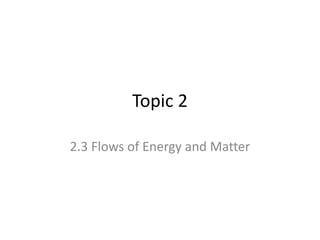
Energy Flows and Cycles in Ecosystems
- 1. Topic 2 2.3 Flows of Energy and Matter
- 2. Energy Flow • About half of the Sun’s total radiation is visible light • Only visible light is useful for photosynthesis • Producers use very little of the visible light available to produce biomass (about 0.06% of the Sun’s total radiation is captured by producers) – The remainder is reflected, transmitted or is not the correct wavelength of light for photosynthesis. Photosynthesis itself is not an efficient process (typically 0.1 - 2.0% efficient)
- 3. The Fate of Solar Radiation • Energy takes 8 minutes to radiate from the Sun to the Earth • The energy leaving the Sun is about 63 million J s-1 m-2 • Only about 40% of this energy reaches ground level on Earth • Photosynthesis is only 30 – 40% efficient
- 4. Productivity • Primary Productivity (PP) – The gain in energy or biomass by producers per unit area per unit time • Secondary Productivity (SP) – The gain in energy or biomass by heterotrophs per unit area per unit time PP involves the conversion of solar energy – it is dependent on the amount of sunlight, temperature, CO2 etc. SP involves feeding or absorbtion – it is dependent on how much food is available and how efficiently it can be turned into biomass Productivity is measured in kJ m-2 yr-1
- 5. Gross Productivity • Gross Primary Productivity (GPP) – The total gain in energy or biomass by producers per unit area per unit time, not taking any losses due to respiration into account • Secondary Productivity (GSP) – The gain in energy or biomass by heterotrophs per unit area per unit time, not taking any losses due to respiration and defaecation into account Losses are caused at each trophic level by respiration You could compare this idea to money flow - your GROSS income is the total amount of money you earn - your NET income is the amount of money you have after losses due to taxation etc.
- 6. Net Productivity • Net Primary Productivity (NPP) – The total gain in energy or biomass by producers per unit area per unit time, taking losses due to respiration into account (R) • Net Secondary Productivity (NSP) – The gain in energy or biomass by heterotrophs per unit area per unit time, taking losses due to respiration (R) and defaecation (F) into account The net productivity values are more useful as they give you information about how much energy or biomass is available from one trophic level to the next
- 7. Maximum Net PP in Some Biomes 0 20 40 60 80 100 120 NetPrimaryProductivity(103kJm-2yr-1)
- 9. Calculations NPP = GPP – R NSP = GSP – F – R NPP GPP (from photosynthesis) R R F NSP Energy flow in ecosystems
- 10. Howard Odum • Ecologist who made the first full analysis of a whole ecosystem – Silver Springs, a stream system in Florida • He measured all inputs and outputs in terms of organic matter and energy • He calculated productivity in kcal m-2 yr -1 • He represented his data as a productivity diagram and an ecosystem model • In his models he developed a symbol language similar to that used in electronics
- 11. Transfers and Transformations • The simple movement of energy or matter is a transfer • The change of energy or matter from one form to another is a transformation • Transfers are simpler, require less energy and are therefore more efficient • We usually think of energy as being transferred and chemicals (like nutrients) being transformed • Nutrients are transformed into different chemical forms as they pass through trophic levels • You need to know 3 natural cycles: – The carbon cycle (transformation of matter) – The nitrogen cycle (transformation of matter) – The water cycle (transfer of matter)
- 14. The Water Cycle (The Hydrological Cycle)
- 15. Questions 1. Without referring to your notes, draw an outline of the carbon, nitrogen and water cycles 2. Why is not all of the energy assimilated by one trophic level available to the next one? 3. Without referring to your notes, write formulas for the calculation of NPP and NSP (defining each term)
- 16. Questions 4. If a forest has a gross primary productivity of 6.5 gm-2d-1 and a net primary productivity of 4.0 gm-2d-1, what are its energy losses due to respiration? 5. A field of cows has a gross secondary productivity of 5.0 tonnes C m-2yr-1, produces 0.5 tonnes C m-2yr-1 in cowpats and loses 2.1 tonnes C m-2yr-1 in respiration. What is its net secondary productivity?
- 17. Questions Biome Mean NPP (kg m-3 yr-1) Desert 0.003 Tundra 0.14 Temperate grassland 0.60 Savannah 0.90 Temperate forest 1.20 Tropical rainforest 2.20 6. Compare and contrast the NPP of each biome 7. Why is there a difference between the NPP of temperate grassland and savannah?
